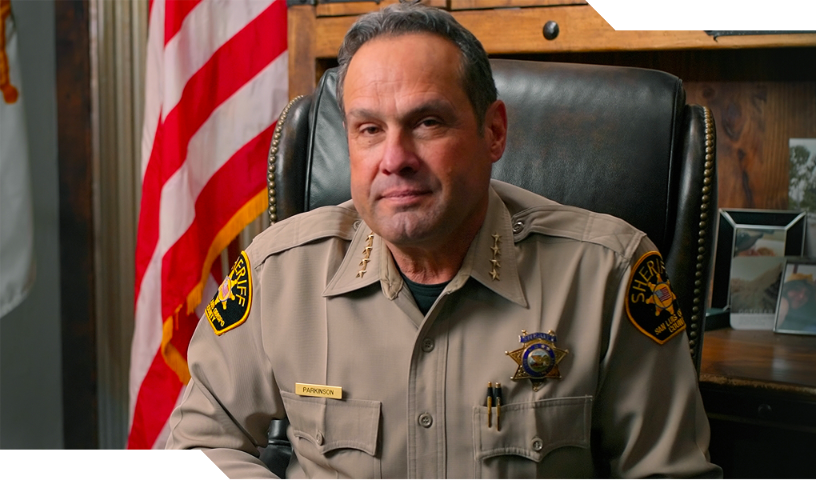FirstNet: The power behind San Luis Obispo County sheriff’s public safety response

“FirstNet® has given me peace of mind because it has proven itself to be dependable.”
The San Luis Obispo County Sheriff's Office comprises approximately 450 people, including about 250 sheriff’s deputies. Our agency has various responsibilities, such as patrol, custody division, coroners division, investigative division and more.
We cover approximately 3,600 square miles divided into seven patrol beats. To give a sense of scale, one of our smallest beats is larger than some California counties. It’s a vast area geographically and our population of around 300,000 spreads across the entire region.
We have around 100 miles of beachfront on one side. As you move further east into the county, you'll find mountain ranges and a thriving agricultural industry, with farming and ranching.
Our region is incredibly diverse, with various landscapes and industries from north to south and east to west, which presents unique challenges, particularly regarding communication and access.
Agency Responsibilities
Unfortunately, our primary responsibility along the coast involves search and recovery efforts. For instance, the Coast Guard or Harbor Patrol are usually the first to respond if a boat sinks. And sometimes the people involved are no longer in sight. In that case, it becomes a recovery effort and we dispatch our dive team.
We also respond to plane accidents in the water, distressed swimmers and other recreational water-related incidents. We’ve even used our dive team on the more remote coastal areas with no beach access other than by helicopter. In such cases, we transport our divers by helicopter and make the recovery entirely by water.
Challenges in Communication
We are in Region 1A, which includes Santa Barbara and Ventura County. As part of this system, we need to be able to communicate with each other effectively. There are so many agencies across the three counties. And only some of those agencies have the other agencies on their radio system. So, during disasters we communicate with neighboring agencies primarily through cellular service.
That’s one of the reasons we are on FirstNet.
We had a prime example of this a couple of years ago when we had an active shooter in the northern end of our county. He had shot at the police department and we responded to assist. Unfortunately, while we were searching for the shooter, he shot one of my deputies in the head.
During the search, we relied heavily on FirstNet to ensure that we kept our connection. Communication was critical as it was our lifeline and the means of preventing another tragedy from happening.
The search for the shooter lasted 36 hours as he hid and continued shooting. He shot another officer in the leg the following day before we eventually caught him. The challenge was that we had a vast area to cover, and we had multiple agencies, including those from the Central Valley, to come and assist us.
Importance of FirstNet
Our primary use of FirstNet is in our cars and MDCs because it provides us with data that we would not usually be able to push to our deputies. Our deputies and investigators carry phones that are on FirstNet, giving them reliable access to information even when they are outside of their cars.
We also use FirstNet for our cameras and some of our camera systems. For example, we have cameras all over the county for protection and reading license plates. Having a reliable signal is important for these cameras to work effectively. FirstNet provides that.
For several years, we had problems with boats from Mexico smuggling drugs or people. Almost all the coastal counties had this problem. A boat would land on a beach in a remote area and they would either unload their drugs or let people off into the country illegally.
Challenges of the Coast
The challenge regarding the coast, especially as you travel up our county's coast, is that communication becomes more difficult due to the mountain range. But we have seen a dramatic change in our ability to get a communication signal with FirstNet.
When we are out on patrol looking for smugglers, we watch for unusual vehicles at that time of night. For example, traveling along the coast at 2 a.m. is unusual for a large box van. So, we are constantly on the lookout for these things.
Having the ability to deploy license plate readers and cameras gives us a tremendous advantage. We don't have to be at that location when that vehicle arrives. Our multiple use of aids – such as cameras and license plate readers – is one of the reasons we have successfully captured so many smugglers.
We were one of the leading counties for drug seizures. Our success led to a drop-off in these types of incidents. And we haven't had one in many years. But we did catch a lot of people and seized a lot of drugs. The use of technology was instrumental in our success.
Reliability of FirstNet
FirstNet has given me peace of mind because it has proven itself to be dependable. As a leader, I feel a great responsibility for the safety of my community. And FirstNet helps me fulfill that responsibility.
Ian Parkinson is a veteran law enforcement officer with 39 years of experience, currently serving as Sheriff-Coroner in San Luis Obispo County. He spent 27 years at a police department before being elected for his first term in 2010. He is currently serving his fourth term in office.